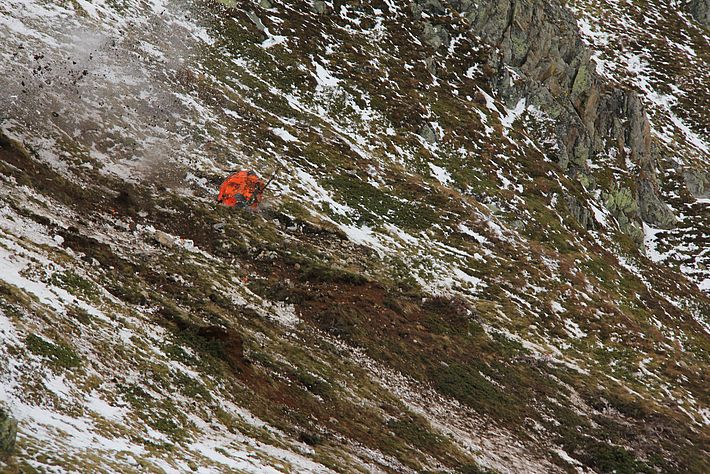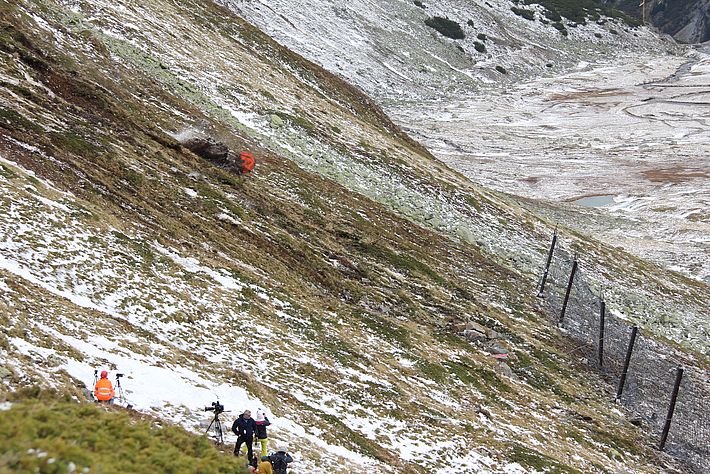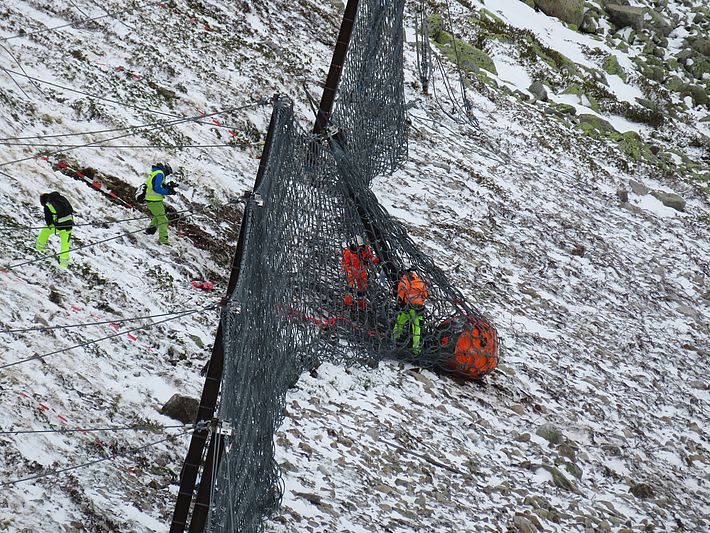Over the past two years, the WSL Institute for Snow and Avalanche Research SLF and Geobrugg AG have been conducting tests on the Flüela Pass to find out how realistic impacts by test blocks affect rockfall barriers. The initial results of this Innosuisse project are now available as a WSL report.
Test with a 3.2 tonne cube-shaped concrete block (08.10.2020, video: SLF/E. Frei)
The first tests with rockfall barriers were conducted in the late 1980s and early 1990s, although some of these involved a more 'natural' approach of simply rolling rocks down a slope and letting them hit a barrier. The test blocks kept changing tracks depending on the terrain, jumping about and therefore hitting the net in different places in an uncontrolled way. While these tests provided valuable basic knowledge about the performance of such protection systems, it soon became clear that the significance of tests carried out in this way was very limited. They did not allow any meaningful comparisons to be made between different protection systems, as too many different parameters were involved.
A test method was subsequently developed that enabled a real comparison to be made between systems on the basis of predefined, controllable parameters. Agreement was reached on what has now become the established method. This includes a maximum energy level (MEL) test, involving a single impact in the middle section of the barrier, and a service energy level (SEL) test, involving two successive impacts in the middle section.
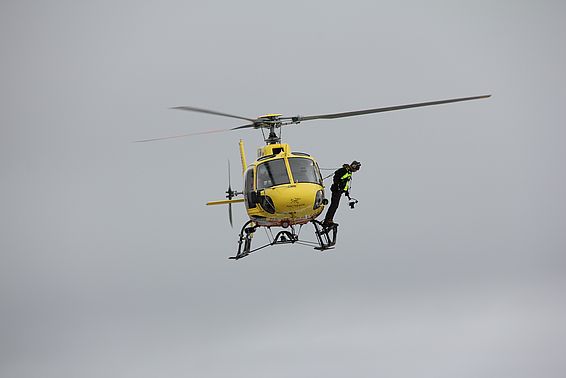
In recent decades, flexible rockfall barriers made of high-tensile steel wire nets have become established worldwide as an efficient and reliable protective measure. Over the same period, the energy absorption capacities have increased from 1,500 kJ to as much as 10,000 kJ. Given such high energy levels and the increased height of some of the defensive structures, the question inevitably arises again how these structures respond to 'natural' impacts, i.e. impacts from boulders that hit the net at any point, potentially also rotating as they do so.
As part of an Innosuisse (Swiss Innovation Agency) research project, the SLF and industrial partner Geobrugg AG have been carrying out an extensive series of field tests since 2019 to determine the effects of different load cases on rockfall protection barriers. Taking place on natural terrain near the Flüela Pass, the tests involve dropping blocks of different shapes and sizes into a rockfall barrier. Both the blocks and the barrier itself are equipped with various sensors to measure the load on different elements of the protection system. For example, the researchers examine how different impact positions and speeds and the rotation of the test blocks affect the behaviour of the barrier.
The sensors in the test blocks measure the rotation and acceleration of the block as it descends and when it hits the barrier. This information, combined with high-resolution drone footage and videos taken from a range of angles, allows the trajectories and speeds of the blocks to be reconstructed in detail, which enables the researchers to learn more about the interaction of the various parameters.
Evaluation of the data has shown that it is now possible to carry out additional tests that were conceived in the 1990s but were not really viable back then due to the much less sophisticated sensor and computer technology available at the time. These tests supplement the mandatory testing. The SLF's objective is to further refine the RAMMS::Rockfall simulation software. For Geobrugg, the focus is on optimising its barriers to cope even better with rockfalls as they occur under natural conditions, thereby building on experiments already carried out on the test site.
WSL Institute for Snow and Avalanche Research SLF
The SLF is part of the Swiss Federal Research Institute WSL and thus belongs to the ETH Domain. It engages in research and scientific services with a focus on snow, avalanches, other alpine natural hazards, permafrost and mountain ecosystems. Its best-known service is the avalanche bulletin.Geobrugg, part of the BRUGG Group
Geobrugg is an independent group of companies within the BRUGG Group and specialises in the fabrication of high-tensile steel wire safety nets and meshes. These systems protect against natural hazards such as rockfall, landslides, debris flow and avalanches, and ensure safety in mining and tunnelling as well as on motorsport tracks. More than 65 years of experience and close collaboration with research institutes and universities make Geobrugg a pioneer and leading expert in these fields.
Pictures of the rockfall tests on the Flüela Pass on 08.10.2020 ¶
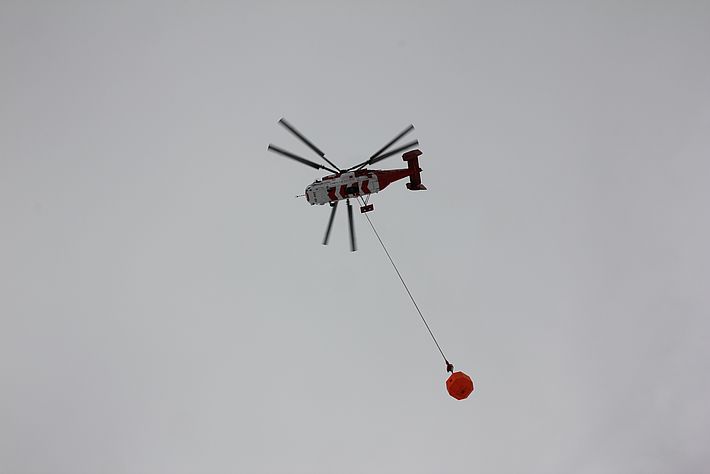
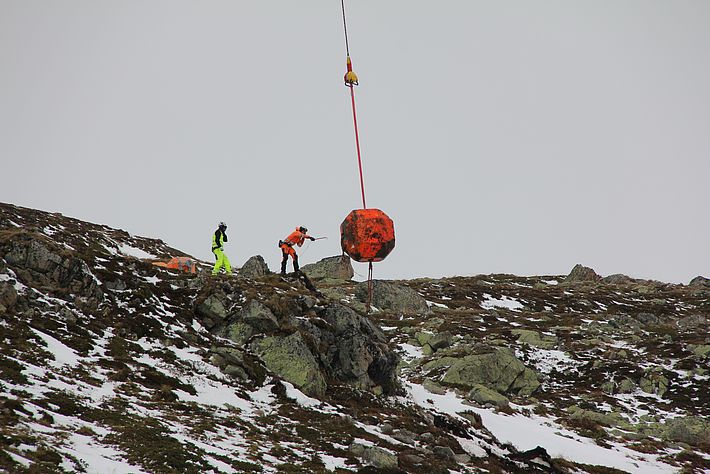
Links ¶
Copyright ¶
WSL and SLF provide the artwork for imaging of press articles relating to this media release for free. Transferring and saving the images in image databases and saving of images by third parties is not allowed.

